 |

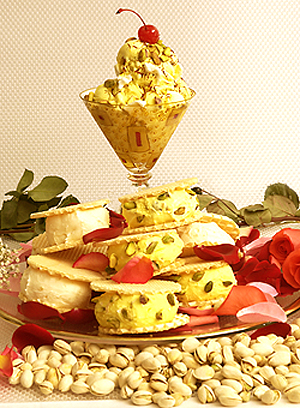 |
 |

Mashti Malone's Exotic Ice Cream: Nice Ice, Baby!
Alluring, exciting and definitely addictive, Mashti Malone’s Exotic Ice Creams and Sorbets, a selection of largely rosewater-based frozen delights, have been thrilling mainstream Los Angelinos, who for several years have voted it the best ice cream in town. Thanks to Federal Express, you can have it delivered to your doorstep overnight, frozen solid in dry ice and ready to excite local ice cream experts (i.e., you and your friends).
They might not sound like your everyday trip to the scoop shop, but in this lifetime, don’t miss the Creamy Rosewater, Rosewater Saffron, Orange Rosewater and Lavender ice creams and the Rose and Herbal Snow Sorbets. Throw out any unhappy reference to rosewater-flavored desserts you may have had. Once you’ve tried Mashti’s miracles, you’ll be seeing a lot more of the FedEx delivery truck.
The line is kosher, and Non-Dairy Rosewater ice cream made from soymilk is a parve, vegan and lactose-intolerant option. At the very least, get the three-quart assortment of our favorite flavors plus a package of sandwich wafers; but to quote Marlene Dietrich in Anna Christie, “Don’t be stingy, baby.” This ice rocks. The line is certified kosher (dairy) by Igud Hakashrus of Los Angeles. Read the full review below.
- Read about our other favorite desserts in THE NIBBLE online magazine.
- See the table of contents for the March issue of THE NIBBLE, plus the back issues archive.
|
Sultans, shahs, Los Angelinos....and you can enjoy exquisite ice creams from Mashti Malone’s. Shown above, Saffron Rosewater Ice Cream with Pistachios, with a few Creamy Rosewater Ice Cream sandwiches for good measure.
|
|
| WHAT IT IS: Mashti Malone’s Exotic Ice Creams & Sorbets—Persian flavors of ice cream and sorbet. |
| WHY IT’S DIFFERENT: Most have rosewater or orange blossom water plus other Persian flavors like saffron and cardamom. |
| WHY WE LOVE IT: We, and much of Los Angeles (it’s been voted the best ice cream in town by almost every media outlet) adore the exquisite flavors, silky yet chewy texture, and amazingly refreshing taste. It’s addictive: once you have it, you can’t live without it. |
| PURCHASE AT: MashtiMalones.com and fine retailers. |
|
|
You Scream, I Scream
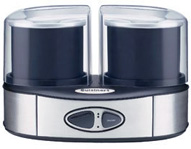 |
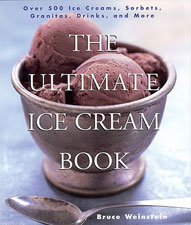 |
 |
| Want to make your own ice cream? The easy-to-use Cuisinart® Flavor Duo machine makes two different flavors of ice cream, sorbet or frozen yogurt at the same time. You’ll find yourself making great desserts for company or every day... maybe you’ll be the next Mashti. Click here for more information. |
How about 500 great ice cream recipes for that ice cream machine? With delicious recipes for more than 500 ice creams, sorbets and granitas, you and your ice cream machine will be busy for several years—and your popularity quotient will soar. Click here for more information—and let us know what your favorite flavors are. |
Want to know more about the history of ice cream? This book has great pictures and graphics, the fascinating history of ice cream, and anecdotes and factoids that will make you popular at ice cream parlors and cocktail parties. It gets 5-star raves from those who have bought it. Click here for more information. |
Mashti Malone’s Exotic Ice Creams & Sorbets: Nice Ice, Baby!
Quite a few years ago, a wonderful advertising campaign for a Jewish-style rye bread (named one of the top 100 campaigns of the 20th century by Ad Age) showed people of every ethnicity except Jews—Asians, African-Americans, Native Americans, Eskimos, WASPs—happily enjoying the bread. The headline read, “You don't have to be Jewish to love Levy’s.” Borrowing a page from that adbook, we start this NIBBLE with: You don’t have to be Persian to love rosewater-based ice cream.
Mashti Malone’s Exotic Ice Creams and Sorbets, created by Iran-born Mashti Shirvani, have been going strong in Los Angeles for more than 25 years, where they have a cult following. Younger brother Mehdi (a.k.a. Matt) joined him to handle the growing business while Mashti focuses on creating the product. We’d been hearing about Mashti Malone’s for the past five years or so because it invariably gets voted “best ice cream in L.A.” Thanks to the affordable pleasure of having the best gourmet ice creams in America delivered overnight from wherever they are to wherever we are, we finally received a freezerful of our own. We tend not to put too much stock in most of the “best of whatever” contest winners, as we more often than not have a differing opinion. But L.A., you’re dead right on this one! Our feelings are running somewhere between jubilant and numb, because we can’t stop eating Mashti’s ice cream. Although we’ve piled on cashmere sweaters and wooly socks, our lips are still blue—but happily so.
Even if you haven’t liked previous dishes made with rosewater, and even if you don’t like Middle Eastern food, these amazing ice creams are worth the culinary journey. One enthusiastic fan commented that it was worth the plane fare, hotel and car rental to Hollywood to get Mashti’s ice cream—but perhaps he has not heard of Federal Express, which will efficiently bring them to his door overnight.
At our tasting, jaded palates were ecstatic. Other delights on that day’s tasting agenda were pushed aside like yesterday’s salad. We were not just elated; we were serene and reflective. When you find something that is so different and so good, excitement leads to introspection. Or perhaps it’s something in the rosewater.
So, What Is Rosewater?
As the name suggests, rosewater, or rose flower water, and its sister, orange blossom water, are liquids made by steeping or distilling the flower petals in water. Rosewater is the 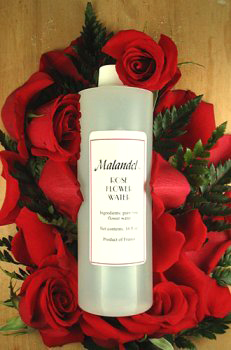 number one flavoring in the Middle East (it’s also popular in Greece, North Africa and India)—their equivalent of vanilla. Pastries, puddings, scented rice and cooked fruits are accented with rosewater; Turkish sultans feasted on rice pudding flavored with rose water; Turks and Greeks use it to flavor baklava and other phyllo desserts and Turkish Delight candies, as well as ice cream and sorbets. Orgeat syrup, used in many cocktails, is an almond syrup flavored with rosewater or orange blossom water. number one flavoring in the Middle East (it’s also popular in Greece, North Africa and India)—their equivalent of vanilla. Pastries, puddings, scented rice and cooked fruits are accented with rosewater; Turkish sultans feasted on rice pudding flavored with rose water; Turks and Greeks use it to flavor baklava and other phyllo desserts and Turkish Delight candies, as well as ice cream and sorbets. Orgeat syrup, used in many cocktails, is an almond syrup flavored with rosewater or orange blossom water.
You can easily purchase rosewater and orange blossom water at Middle Eastern food, baking supply and specialty food stores. The finest quality products, harder to find, are French-distilled. (You can purchase one bottle each of the French-distilled rosewater and orange blossom water by clicking here.) You can use either to flavor panna cotta, and can add a splash to tapioca or rice pudding and sprinkle them with chopped pistachios to make a simple but impressive dessert. Add them to ricotta cheese desserts and Italian sponge cakes, cookies and biscotti. Add a teaspoon to crème fraîche. And for a remarkable, refreshing, calorie-free beverage, sprinkle a few drops into ice water and add some saffron threads.
Mashti Malone Ice Cream Flavors
|
The slogan on the cartons of Mashti Malone’s ice cream proclaims, “2500 Years In The Making™.” It has been well worth the wait. Each of the flavors is excellent; most are absolutely exquisite. It would not be extravagant to order one of everything and invite a group of friends over to enjoy them. You won’t have “too much”; in fact, you’ll wish you had ordered more.
Ice Creams
The ice creams are all-natural and rBGH-free; they are made from cream and milk plus condensed skim milk and whey for added chewiness.† They have a beautiful texture and weight: just perfect, without being rich or heavy.
†What makes ice cream chewy? For a fascinating overview of the ingredients in ice cream, including an explanation of locust bean gum and carrageenan, click here.
That rosewater is an ingredient in most flavors doesn’t mean there’s a sameness running through the line. Think of regular chocolate chip ice cream in a vanilla base contrasted with mint chip, double fudge chip and raspberry chip. Chocolate chips are a common ingredient, but the ice cream flavor experiences are totally different. |
|
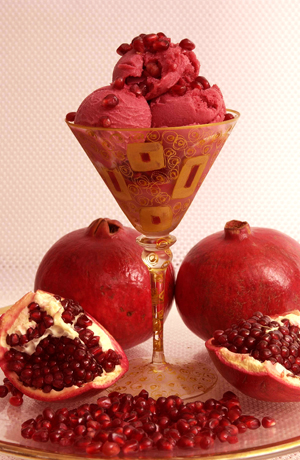
Pomegranate sorbet.
|
You’ll find the same with Mashti’s treasure trove of:
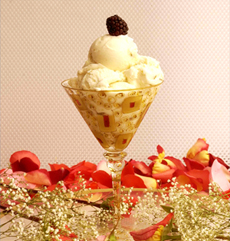 Creamy Rosewater Ice Cream (photo at right). The traditional Persian ice cream, this flavor is delightful yet deceptive: You might think you were eating vanilla until the subtle flavor of rosewater pops up on the finish. The color of butter, this flavor hides a surprise: cream chips, rectangles of frozen cream about 1/2-inch long, the same buttery color, that provide a textural bite (like chocolate chunks but with a hit of cream instead of chocolate). Wonderful by itself, we paired Creamy Rosewater with chocolate cake, then with molten chocolate cake and banana bread. Given a steady supply, we would never return to vanilla. Creamy Rosewater Ice Cream (photo at right). The traditional Persian ice cream, this flavor is delightful yet deceptive: You might think you were eating vanilla until the subtle flavor of rosewater pops up on the finish. The color of butter, this flavor hides a surprise: cream chips, rectangles of frozen cream about 1/2-inch long, the same buttery color, that provide a textural bite (like chocolate chunks but with a hit of cream instead of chocolate). Wonderful by itself, we paired Creamy Rosewater with chocolate cake, then with molten chocolate cake and banana bread. Given a steady supply, we would never return to vanilla. - Ginger Rosewater Ice Cream. Surprisingly, since Mashti promotes this flavor in two of his three combo packages, Ginger Rosewater is perhaps the least articulated flavor: the rosewater subtly predominates, and the ginger is a background note. It’s creamy and delicious, but those accustomed to more flavor-forward ginger ice creams may wish for more of a ginger hit.
- Lavender. This rich ice cream, vivid lavender in both flavor and color, is a dream come true for lovers of lavender. We count ourselves among them. It was hard to share.
- Orange Blossom With Pistachios Ice Cream. So light, yet so packed with the flavor of orange blossoms; except for the pistachios studded throughout, this divine ice cream could transport you to a Florida orange grove as easily as to the Middle East. Said one of our tasters, “I feel like I’ve stepped into a flower” (and that’s a good thing). We love it by itself,
à la mode with anything, or in a coupe with other flavors. We would be tickled pink if Mashti made a whole line of orange blossom water ice creams.
- Non-Dairy Rosewater Ice Cream. Available this summer, a soymilk-based ice cream will bring the joys of rosewater ice cream to vegans, the lactose-intolerant and kosher diners seeking a parve ice cream (the line is kosher, and the sorbets are parve). Mark your calendars!
- Saffron Rosewater With Pistachios Ice Cream. This is the ice cream in the photo at the very top of the page, a beautiful buttercup yellow color. You can purchase the wafers separately (or order the Family Medley pack) and make your own ice cream sandwiches. The saffron is subtle; rosewater and luscious pistachios predominate. It’s an incredible combination of tastes, and if you’re an ice cream sandwich fan, adding the wafers may bring on delirium.
- Turkish Coffee. An intense coffee ice cream experience, this may spoil you for any other coffee ice cream. To those who think Starbucks makes the most intense coffee flavors: You ain’t seen nothing yet.
Sorbets
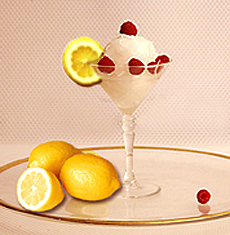 Herbal Snow Sorbet (photo at right). Crunchy, almost like a granita, flavored with rosewater and lime and speckled with basil and poppy seeds, this is the most unusual of the group in texture and flavor. It is thrilling in a way: it’s the closest we can imagine to the sharbat of antiquity, enjoyed by royalty who had snow brought from the mountains to be mixed with fruit juices, syrups and honey. It’s our historic link to Alexander the Great and Emperor Nero (more about that below). Perhaps the most exotic product in the line; we love it. Herbal Snow Sorbet (photo at right). Crunchy, almost like a granita, flavored with rosewater and lime and speckled with basil and poppy seeds, this is the most unusual of the group in texture and flavor. It is thrilling in a way: it’s the closest we can imagine to the sharbat of antiquity, enjoyed by royalty who had snow brought from the mountains to be mixed with fruit juices, syrups and honey. It’s our historic link to Alexander the Great and Emperor Nero (more about that below). Perhaps the most exotic product in the line; we love it. - Pomegranate Sorbet. Pomegranate emerged last year as the latest hot flavor in specialty food circles, a fact that probably would amuse Mashti, who grew up where pomegranates are as common as apples. This is a lovely, refreshing sorbet; if you are ordering one of everything, do try it. However, it comes down to being another very good fruit sorbet as opposed to a rare experience. We like it—we ate every last drop—but there is greater excitement to be had in this line.
- Rose Sorbet. This, like Herbal Snow, is a rare experience: a very pretty light coral color with fine threads of starch noodles (like rice noodles, but made of wheat) that add visual beauty and crunch. As with the Orange Blossom With Pistachios Ice Cream, you step into the very essence of the flower, and it is a rare experience. Next time, don’t send a dozen roses: send a few quarts of Rose Sorbet. It is a great palate cleanser between fish and meat courses, a dazzling dessert, an invigorating refreshment. In Persian circles, rose sorbet, called faludeh, is as ubiquitous a dessert as ice cream is in the U.S. Served in a bowl, it is generally garnished with sour cherries and/or a drizzle of sour cherry syrup, a squirt of lime juice and pistachios. We didn’t serve it in the traditional way: could it be more perfect than it already is, straight from the quart? We’ll have to rustle up some sour cherries and find out.
The Verdict
Everything is superb, but on our “don’t miss list” (in alphabetical order):
- PRIORITY 1: Orange Blossom With Pistachios Ice Cream, Rose Sorbet, Saffron Rosewater With Pistachios Ice Cream. Fortunately, this selection is available in an assortment called “Family Medley” (one quart of each plus a package of wafers for ice cream sandwiches for $23.50). If you love lavender and coffee, don’t miss Mashti’s.
- PRIORTY 2: Creamy Rosewater Ice Cream, Herbal Snow.
- PRIORITY 3: Everything else. It’s all wonderful, including the Creamy Mango Ice Cream we didn’t taste, but we’ll vouch for.
When Mashti Shirvani opened for business, his customers were largely wholesale accounts, Persian and Armenian restaurants that would normally have rosewater-based desserts on the menu. The store also offers some Western flavors, and it took a while to convince most American customers to try the Persian ones. Once tried, however, once converted. If you’ve previously enjoyed discovering chipotle, wasabi and yuzu and are wondering what mainstays of other cultures might next dazzle your palate, might we suggest rosewater and orange blossom water?
The ice cream review continues below the yellow box.
Ice Cream: An Ancient Treat
It’s logical to think of ice cream as a modern food because freezing technology is relatively recent. But mankind has been enjoying ice cream for thousands of years: up to 4,000 years ago, the Chinese elite enjoyed an ice milk made with milk, overcooked rice and spices, packed in snow to harden. Fruit ices were also developed, prepared with fruit juices, honey and aromatic spices. Through trade routes, they were introduced to the Persians about 2,500 years ago. (The Persian Empire included the countries of what we now know as Iran, Afghanistan, Azerbaijan, Turkey, and portions of western China and northern Iraq.)
- The Persians drank syrups cooled with snow called sharbat (“fruit ice” in Arabic, and the derivation of sherbet, sorbet and sorbetto); the Greek Alexander the Great, who battled the Persians for 10 years before finally toppling the Persian Empire in 330 B.C., enjoyed fruit “ices” sweetened with honey and chilled with snow. Three centuries later, Emperor Nero’s famous banquets always included fruit juices mixed with honey and snow.
- Sorbetti and pasta arrived in Italy with the Arab invasions of Sicily in the 5th century (the Marco Polo story is a myth). Italian granita was born, flavored with fresh citrus, a wide range of fruits, and coffee.
- At some point in Italy, gelato was developed, enriching the sorbetto with cream and eggs. The tipping point is unknown, but it definitely did not happen with 14-year-old Catarina de’ Medici, who allegedly brought it to France when she married the duc d’Orléans, the future King Henri II of France in 1533. This is myth: the freezing technology for for true ice cream had yet to be developed.
- Like most new foods—tea, coffee, sugar, chocolate—ice cream was for the first 100 or 200 years a pleasure of the wealthy. Only they could afford to purchase ice that was cut in the winter and stored underground to make ice cream in the warmer months; only the wealthy had chefs who knew the secrets of making ice cream.
George Washington had two ice cream freezers installed at Mount Vernon, Thomas Jefferson was equally fond of it, and Dolley Madison was famous for serving it at White House state dinners.
- As with most foodstuffs, by the 19th century, ingredients and technology, including the development of ice harvesting and the invention of the insulated icehouse, had evolved to give the public affordable access. In 1846, American Nancy Johnson invented the hand-cranked ice cream freezer. In 1851, a Baltimore milk dealer named Jacob Fussell established the first large-scale commercial ice cream plant.
- Whether from a street vendor, the ice cream parlor, or a package picked up at the corner drug store (these were the days before grocery stores had frozen food cases), all of America had access to ice cream. During the 1950s, competition sprang up between the ice cream parlors and the drug stores that sold packaged ice cream. It was during this time that usage of lesser-quality ingredients increased: many producers were adding very low percentages of butterfat, pumping large quantities of air (overrun) into the ice cream to fill out the carton and using artificial flavorings to save on the cost of ingredients.
- The 1970s saw a return to quality via the emergence of “premium” boutique brands like Häagen-Dazs, with high butterfat content and low overrun. Thanks to the new electric home ice cream machine—no more hand cranking—more people became interested in making ice cream at home.
- With today’s fusion cuisines introducing chipotle fudge chip ice cream and lime wasabi sorbet (both delicious), the number of flavors is endless; estimates of 1,000 flavors are inadequate when local boutique companies that specialize in novelty flavors list 100 rotating choices on their rosters.
- But most of the ice cream sold in America is still vanilla followed by chocolate. The numbers are based on sales of supermarket half-gallons, not on superpremium pints, which represent just 3.5% of sales (premium brand half-gallons are 51.5%, and regular half-gallons are 45% [source IRI]).
Visiting L.A.?
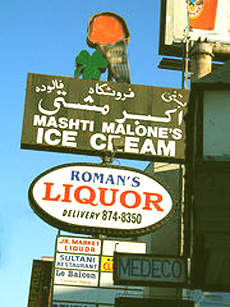 If you can get to La Brea and Sunset in Hollywood, stop in Mashti Malone’s shop. You’ll be surprised: this shrine to unforgettably great ice cream is in the middle of a drab mini-mall with unglamorous neighbors that include a dentist, a locksmith, a print shop and a liquor store. Don’t expect silver coupe dishes: while the ice cream is fit for a shah, it is served in a plastic cup. There are a few tables inside; some outdoor tables border the parking lot. If you want a more charming ambience, head to the Glendale store. If you can get to La Brea and Sunset in Hollywood, stop in Mashti Malone’s shop. You’ll be surprised: this shrine to unforgettably great ice cream is in the middle of a drab mini-mall with unglamorous neighbors that include a dentist, a locksmith, a print shop and a liquor store. Don’t expect silver coupe dishes: while the ice cream is fit for a shah, it is served in a plastic cup. There are a few tables inside; some outdoor tables border the parking lot. If you want a more charming ambience, head to the Glendale store.
Atmosphere aside, how did this most exotic of creameries, which also sells Middle Eastern candies, end up with an Irish last name? Mashti Shirvani moved in to a space that previously housed an ice cream parlor called Mugsy Malone’s. He couldn’t afford a new sign, so Mugsy became Mashti. See it for yourself at:
- 1525 North La Brea Avenue
Los Angeles, California, 90028
1.866.767.3423
Hours: Monday to Friday, 11 a.m. to 11:30 p.m.
Saturday to Sunday, 11 a.m. to 12 p.m.
- 143 North Maryland Avenue
Glendale, California 91206
1.818.662.0400
Hours: 11 a.m. to 10 p.m. daily
If you’re traveling with someone who is more of a vanilla person, there is Vanilla as well as Black Cherry, Chocolate and Pistachio, and they are wonderful. Turkish Coffee is a dense and delectable ice cream version of coffee candy. We can’t believe we ate the whole thing. (These flavors currently are not available online.) |
Yesterday’s arrival of the vernal equinox, the first day of spring, is also the beginning of Nowruz, the Persian New Year. Nowruz is a celebration of the renewal of nature after the slumber of winter, and continues through April 1st, the thirteenth day of spring. With roots back to Zoroastrianism, one of the world’s oldest religions, it has been celebrated for at least 3,000 years. This year, our Persian friends invited us to celebrate; and while ice cream, even faludeh, is not one of the traditional foods served, we may have inspired a new tradition.
You don’t need a special holiday. Whether during Nowruz or anytime thereafter, Mashti Malone’s ice creams and sorbets are their own reason to celebrate.
—Karen Hochman
Updated August 2008
FORWARD THIS NIBBLE to anyone who loves ice cream and exciting flavors, and to people who are always looking for something new and fabulous to serve at parties.
Mashti Malone’s ORIGINAL ROSEWATER ICE CREAMS
ICE CREAMS: Creamy Mango, Creamy Rosewater Ice Cream, Ginger Rosewater Ice Cream, Lavender, Non-Dairy Rosewater Ice Cream (available summer 2006), Orange Blossom Ice Cream, Rosewater Saffron Ice Cream with Pistachios, Turkish Coffee
SORBETS:
Herbal Snow Sorbet, Pomegranate Sorbet, Rose Sorbet (Faludeh)
Certified Kosher (Dairy) by Igud Hakashrus
of Los Angeles
- Pints
$4.95 (tip—get the quart size instead,
it’s too good!)
- Quarts
$7.95
- Family Medley Pack
1 quart each: Orange Blossom Ice
Cream, Rose Sorbet, Saffron Rosewater
Ice Cream plus a package of ice cream
sandwich wafers
$23.50
- Pack of Wafers
$3.00
Purchase online at MashtiMalones.com
or telephone 1.866.767.3423.
Soon to be available at natural and specialty food stores nationwide, including some Whole Foods Markets. |
 |
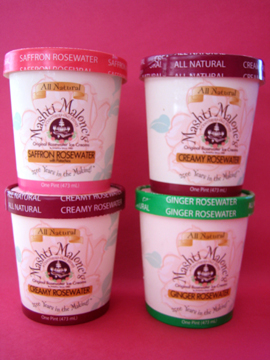 |
| Read about some of our other favorites in these sections of THE NIBBLE: |
|
Before You Eat The Ice Cream, Enjoy Some Persian Cuisine
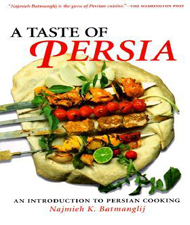 |
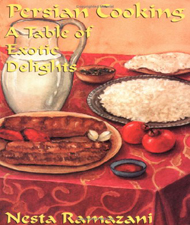 |
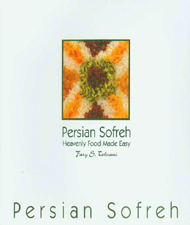 |
| A Taste of Persia, by Najmieh Batmanglij. Learn how to make everything from braised Rhubarb Khoresh to dessert recipes like Rose Water Rice Pudding. A dictionary of Persian cooking techniques and ingredients is also included. Click here for more information. |
Persian Cooking: A Table of Exotic Delights, by Nesta Ramazani. Acquaint yourself with the origins and culture of Persian cuisine. You’ll also find a helpful guide to grocery stores outside of Iran where rare ingredients may be purchased. Click here for more information. |
Persian Sofreh, by Fary S. Tehrani. Create a heavenly Persian feast with traditional, easy-to-follow recipes. Sample menus are also provided, suggesting the most complementary dishes for easy entertaining. Click here for more information. |
FOR ADDITIONAL INFORMATION, special offers, contests, opinion surveys, THE NIBBLE™ back issues archive, product gift-finder, links to our favorite food websites, and the ability to nominate YOUR favorite nibbles, visit the home page of TheNibble.com.
Do you have friends who would enjoy THE NIBBLE?
Click here to send them an invitation to sign up for their own copy. |
ABOUT THE NIBBLE. THE NIBBLE™, Great Food Finds™, is an online magazine about specialty foods and the gourmet life. It is the only consumer publication and website that focuses on reviewing the best specialty foods and beverages, in every category. The magazine also covers tabletop items, gourmet housewares, and other areas of interest to people who love fine food.
© Copyright 2004-2026
Lifestyle Direct, Inc. All rights
reserved. All information contained herein is subject to change at any time
without notice. All details must be directly confirmed with manufacturers, service
establishments and other third parties. The material in this newsletter may not
be reproduced, distributed, transmitted, cached, or otherwise used, except with
the prior written permission of Lifestyle Direct, Inc.
|
 |
|
 |









 Creamy Rosewater Ice Cream (photo at right). The traditional Persian ice cream, this flavor is delightful yet deceptive: You might think you were eating vanilla until the subtle flavor of rosewater pops up on the finish. The color of butter, this flavor hides a surprise: cream chips, rectangles of frozen cream about 1/2-inch long, the same buttery color, that provide a textural bite (like chocolate chunks but with a hit of cream instead of chocolate). Wonderful by itself, we paired Creamy Rosewater with chocolate cake, then with molten chocolate cake and banana bread. Given a steady supply, we would never return to vanilla.
Creamy Rosewater Ice Cream (photo at right). The traditional Persian ice cream, this flavor is delightful yet deceptive: You might think you were eating vanilla until the subtle flavor of rosewater pops up on the finish. The color of butter, this flavor hides a surprise: cream chips, rectangles of frozen cream about 1/2-inch long, the same buttery color, that provide a textural bite (like chocolate chunks but with a hit of cream instead of chocolate). Wonderful by itself, we paired Creamy Rosewater with chocolate cake, then with molten chocolate cake and banana bread. Given a steady supply, we would never return to vanilla.  Herbal Snow Sorbet (photo at right). Crunchy, almost like a granita, flavored with rosewater and lime and speckled with basil and poppy seeds, this is the most unusual of the group in texture and flavor. It is thrilling in a way: it’s the closest we can imagine to the sharbat of antiquity, enjoyed by royalty who had snow brought from the mountains to be mixed with fruit juices, syrups and honey. It’s our historic link to Alexander the Great and Emperor Nero (more about that below). Perhaps the most exotic product in the line; we love it.
Herbal Snow Sorbet (photo at right). Crunchy, almost like a granita, flavored with rosewater and lime and speckled with basil and poppy seeds, this is the most unusual of the group in texture and flavor. It is thrilling in a way: it’s the closest we can imagine to the sharbat of antiquity, enjoyed by royalty who had snow brought from the mountains to be mixed with fruit juices, syrups and honey. It’s our historic link to Alexander the Great and Emperor Nero (more about that below). Perhaps the most exotic product in the line; we love it.  If you can get to La Brea and Sunset in Hollywood, stop in Mashti Malone’s shop. You’ll be surprised: this shrine to unforgettably great ice cream is in the middle of a drab mini-mall with unglamorous neighbors that include a dentist, a locksmith, a print shop and a liquor store. Don’t expect silver coupe dishes: while the ice cream is fit for a shah, it is served in a plastic cup. There are a few tables inside; some outdoor tables border the parking lot. If you want a more charming ambience, head to the Glendale store.
If you can get to La Brea and Sunset in Hollywood, stop in Mashti Malone’s shop. You’ll be surprised: this shrine to unforgettably great ice cream is in the middle of a drab mini-mall with unglamorous neighbors that include a dentist, a locksmith, a print shop and a liquor store. Don’t expect silver coupe dishes: while the ice cream is fit for a shah, it is served in a plastic cup. There are a few tables inside; some outdoor tables border the parking lot. If you want a more charming ambience, head to the Glendale store. 


